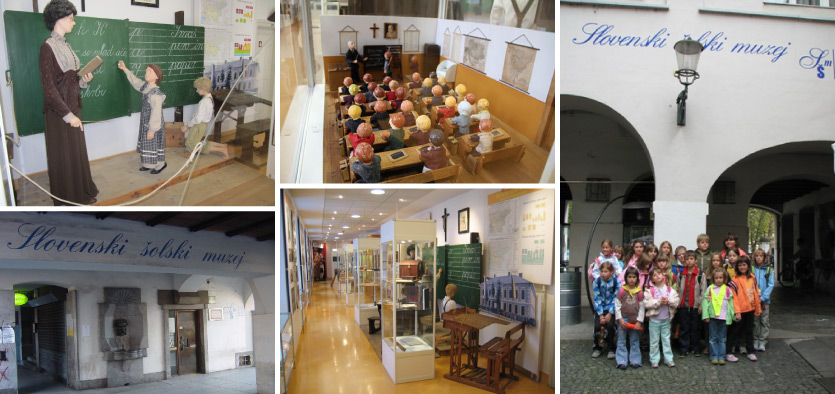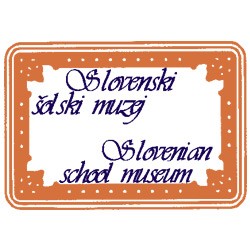Slovenian School Museum
Plečnikov trg 1, 1000 Ljubljana
Telephone
+386 (0)1 251 30 24Website
http://www.ssolski-muzej.si/Historical Significance of the Slovenian School Museum
The Slovenian School Museum in Ljubljana, founded in 1898, is the oldest specialised museum in Slovenia focusing on a specific sphere of man's activities. Unlike the Provincial Museum in Ljubljana (1821) and the municipal museums in Celje (1882) and Ptuj (1895), the Slovenian School Museum was not limited to the territories of the then administrative units; the museum can thus be regarded the first Pan-Slovenian museum. Exhibitions of teaching aids were organised before an institution of this kind came into existence, promoting the idea of a school museum and increasing teachers’ interest for studying the history of schools and pedagogy in the territory populated by the Slovenian nation.
Founded in 1898
The museum was opened due largely to teachers’ increasing awareness of their profession and national background. The idea originally came from Jacob Dimnik, a primary school teacher from Ljubljana, who endeavoured to establish an institution presenting the history of schools and the work of teachers in Slovenia.
On the 50th anniversary of Emperor Franz Joseph's reign, 2 August 1898, the Slovenian Teachers' Association held its annual general meeting where they opened a teaching aids exhibition and established a Slovenian school museum.
Because the museum was dependent on teachers' organisations for financial support and there was no regular funding for its maintenance, its core activities were hindered, and the museum had to move across Ljubljana several times. Its last seat was at the Učiteljska tiskarna printing house, where it was dissolved in 1912.
Re-established in 1938
After the First World War, the progress of education called for the museum's re-opening with the idea that the museum should primarily collect documents providing a detailed picture on the state of schools and education. Restoration, however, was not yet to come about. It was only in the 1930s that the idea was revived by Dr. Karel Ozvald and encouraged by Rudolf Kobilica, head of an experimental school in Ljubljana. Upon his proposal, the educational department of the then bannate issued a special decree on 27 May 1938, establishing a museum of Slovenian education. Since then, the museum's activities as a free-standing institution have never been interrupted.
Structure of the Museum
The museum's primary role, originally defined in 1938, is that of collecting materials on the history of primary and secondary schools operating in the Slovenian territory. This basic concept was revised in 1951, dividing the museum into three separate units, the collection of exhibits, library, and archives and documentation. The museum also began to research all institutions dealing with education. This revised concept defined the museum’s long-term mission and organisational structure. Thanks to the documentation it collected and systematically expanded for all schools located in the Slovenian territory, the museum was entitled the "documentation centre for the history of schooling" in 1960. At the same time, the documentation unit was separated from the archives. On its 100th anniversary, the museum still adheres to the work programme conceived more than ten years ago, but its activities have become much more diverse and varied. Educational activities, such as lectures and workshops intended for youth, have become significant to the museum’s development.
Museum's Activities
In the 100 years of its existence, the Slovenian School Museum has acquired a large collection of exhibits and materials on the history of schools and pedagogy in Slovenia. Its highly qualified staff no longer only collects and conserves museum exhibits, but rather studies and exhibits such items and undertakes research on the history of education.
Especially interesting among the museum's exhibits and materials are the collections of “black and golden books,” including notebooks, certificates, teaching aids, annual school reports, stereoscopic pictures, photographs of school buildings and classrooms, school equipment (desks, chairs, blackboards), and stationery.
The library has preserved a large volume of original Slovenian educational literature ranging from course books, legislation, and curricula from various periods, to teacher newspapers and journals. It presently keeps more than 55,000 books, including many antiquarian educational books from the 18th and 19th centuries, and even a few incunabula, such as Rudimenta grammatices.
The museum houses a permanent exhibition on the education in Slovenia over centuries. Several special exhibitions on school and history of education, accompanied by rich and informative catalogues (86 produced to date), are prepared every year. In addition to the exhibitions, a classroom dating back to the late 19th century is permanently on display. The Slovenian School Museum is a publisher of Šolska kronika - School Chronicle, the only Slovenian periodical dealing with the history and traditions of Slovenian teachers, teacher associations, and the Slovenian school system.

Contact
- E-Mail: This email address is being protected from spambots. You need JavaScript enabled to view it.

